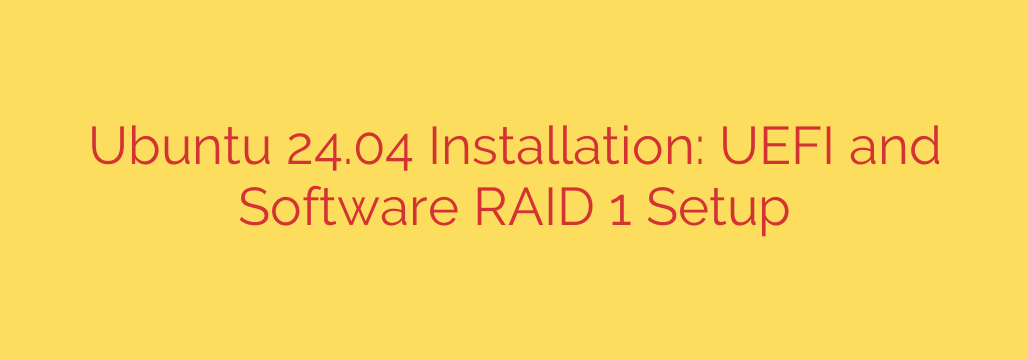
Setting up Ubuntu 24.04 with a UEFI boot and Software RAID 1 for data redundancy provides a robust and reliable system foundation. This process requires careful partitioning during the installation.
Begin by booting the Ubuntu 24.04 installer in UEFI mode. When you reach the installation type screen, choose the “Something else” option to manage partitions manually.
For a Software RAID 1 setup with UEFI, you’ll typically need at least two physical disks of the same size. On each disk, create the necessary partitions:
- An EFI System Partition (ESP): This is crucial for UEFI booting. A size of 500MB to 1GB is usually sufficient. Format it as FAT32 and flag it as “efi” or “boot, efi”. While you could put this on a single disk, for maximum boot redundancy, ideally, you’d create a small ESP on both drives and configure the system to boot from either. However, a common and simpler approach is having the OS partitions on RAID 1 and the ESP on one drive, backed up elsewhere. Let’s focus on the OS on RAID 1 for now.
- Linux RAID partitions: Create one or more partitions on each disk that will be part of the RAID 1 array. For example, you might create a root (/) partition and a swap partition. Size these according to your needs. Mark these partitions for use as “physical volume for RAID”.
After creating the physical volumes, proceed to configure the Software RAID. Select the option to “Configure software RAID”. Create a new MD device. Choose RAID level 1 (mirroring) and select the physical volumes you prepared on your disks to be part of this array (e.g., /dev/sdaX and /dev/sdbX for the root partition, and potentially /dev/sdaY and /dev/sdbY for swap, creating separate RAID devices for each).
Once the MD devices (like /dev/md0, /dev/md1, etc.) are created, format them. Typically, /dev/md0 would be formatted as Ext4 and mounted as the root directory (/). If you created a separate RAID device for swap, format it as swap space.
Go back to the main partitioning screen. Select the EFI System Partition (the FAT32 partition) and ensure its mount point is set to /boot/efi. Select your root RAID 1 device (/dev/md0) and set its mount point to /, formatted as Ext4. Configure swap if you created a RAID swap device.
Crucially, ensure the boot loader installation location is set to one of your physical drives (e.g., /dev/sda), or preferably, configure your UEFI firmware to list both drives as boot options if you mirrored the ESP.
Proceed with the rest of the installation. The installer will format the chosen partitions and install Ubuntu onto your Software RAID 1 array, ensuring that data written to the root partition is mirrored across both physical disks, providing excellent fault tolerance against single drive failure. Post-installation, tools like mdadm can be used to monitor and manage the RAID array. This setup provides a solid, redundant base for your Ubuntu 24.04 system running in UEFI mode.
Source: https://kifarunix.com/install-ubuntu-24-04-with-uefi-and-software-raid-1/








